Tomcat - 线程池的设计与实现:StandardThreadExecutor
上文中我们研究了下Service的设计和实现,StandardService中包含Executor的调用;这个比较好理解,Tomcat需要并发处理用户的请求,自然而言就想到线程池,那么Tomcat中线程池(Executor)具体是如何实现的?本文带你继续深度解析。@pdai
理解思路
我们如下几个方面开始引入线程池的,这里主要从上文Service引入,保持上下文之间的衔接,会很好的构筑你的知识体系。@pdai
- 上文中我们了解到,Executor是包含在Service中的,Service中关于Executor的配置和相关代码如下:
server.xml中service里包含Executor的配置
<Service name="Catalina">
<!-- 1. 属性说明
name:Service的名称
-->
<!--2. 一个或多个excecutors --> // 看这里
<!--
<Executor name="tomcatThreadPool" namePrefix="catalina-exec-"
maxThreads="150" minSpareThreads="4"/>
-->
</Service>
Service中executors相关方法
/**
* Adds a named executor to the service
* @param ex Executor
*/
@Override
public void addExecutor(Executor ex) {
synchronized (executors) {
if (!executors.contains(ex)) {
executors.add(ex);
if (getState().isAvailable()) {
try {
ex.start(); // 启动
} catch (LifecycleException x) {
log.error(sm.getString("standardService.executor.start"), x);
}
}
}
}
}
/**
* Retrieves all executors
* @return Executor[]
*/
@Override
public Executor[] findExecutors() {
synchronized (executors) {
Executor[] arr = new Executor[executors.size()];
executors.toArray(arr);
return arr;
}
}
/**
* Retrieves executor by name, null if not found
* @param executorName String
* @return Executor
*/
@Override
public Executor getExecutor(String executorName) {
synchronized (executors) {
for (Executor executor: executors) {
if (executorName.equals(executor.getName()))
return executor;
}
}
return null;
}
/**
* Removes an executor from the service
* @param ex Executor
*/
@Override
public void removeExecutor(Executor ex) {
synchronized (executors) {
if ( executors.remove(ex) && getState().isAvailable() ) {
try {
ex.stop(); // 停止
} catch (LifecycleException e) {
log.error(sm.getString("standardService.executor.stop"), e);
}
}
}
}
- 和Server、Service实现一样,StandardThreadExecutor也是继承LifecycleMBeanBase;然后实现Executor的接口。

- Tomcat关于Executor相关的配置文档
http://tomcat.apache.org/tomcat-9.0-doc/config/executor.html
准备知识
在理解Tomcat的线程池时,需要有一定的基础,这里推荐学习下JDK关于线程池的设计和实现。
并发基础
- 多线程的出现是要解决什么问题的?
- 线程不安全是指什么? 举例说明
- 并发出现线程不安全的本质什么? 可见性,原子性和有序性。
- Java是怎么解决并发问题的? 3个关键字,JMM和8个Happens-Before
- 线程安全是不是非真即假? 不是
- 线程安全有哪些实现思路?
- 如何理解并发和并行的区别?
- 线程有哪几种状态? 分别说明从一种状态到另一种状态转变有哪些方式?
- 通常线程有哪几种使用方式?
- 基础线程机制有哪些?
- 线程的中断方式有哪些?
- 线程的互斥同步方式有哪些? 如何比较和选择?
- 线程之间有哪些协作方式?
JUC BlockingQueue 和 ThreadPoolExecutor
- 什么是BlockingDeque?
- BlockingQueue大家族有哪些? ArrayBlockingQueue, DelayQueue, LinkedBlockingQueue, SynchronousQueue...
- BlockingQueue适合用在什么样的场景?
- BlockingQueue常用的方法?
- BlockingQueue插入方法有哪些? 这些方法(
add(o),offer(o),put(o),offer(o, timeout, timeunit))的区别是什么? - BlockingDeque 与BlockingQueue有何关系,请对比下它们的方法?
- BlockingDeque适合用在什么样的场景?
- BlockingDeque大家族有哪些?
- BlockingDeque 与BlockingQueue实现例子?
- 为什么要有线程池?
- Java是实现和管理线程池有哪些方式? 请简单举例如何使用。
- 为什么很多公司不允许使用Executors去创建线程池? 那么推荐怎么使用呢?
- ThreadPoolExecutor有哪些核心的配置参数? 请简要说明
- ThreadPoolExecutor可以创建哪是哪三种线程池呢?
- 当队列满了并且worker的数量达到maxSize的时候,会怎么样?
- 说说ThreadPoolExecutor有哪些RejectedExecutionHandler策略? 默认是什么策略?
- 简要说下线程池的任务执行机制? execute –> addWorker –>runworker (getTask)
- 线程池中任务是如何提交的?
- 线程池中任务是如何关闭的?
- 在配置线程池的时候需要考虑哪些配置因素?
- 如何监控线程池的状态?
Executor接口设计
Executor的设计很简单,在理解的时候需要理解两点:
- 1.Tomcat希望将Executor也纳入Lifecycle生命周期管理,所以让它实现了Lifecycle接口
- 2.引入超时机制:也就是说当work queue满时,会等待指定的时间,如果超时将抛出RejectedExecutionException,所以这里增加了一个
void execute(Runnable command, long timeout, TimeUnit unit)方法; 其实本质上,它构造了JUC中ThreadPoolExecutor,通过它调用ThreadPoolExecutor的void execute(Runnable command, long timeout, TimeUnit unit)方法。
public interface Executor extends java.util.concurrent.Executor, Lifecycle {
public String getName();
/**
* Executes the given command at some time in the future. The command
* may execute in a new thread, in a pooled thread, or in the calling
* thread, at the discretion of the <code>Executor</code> implementation.
* If no threads are available, it will be added to the work queue.
* If the work queue is full, the system will wait for the specified
* time until it throws a RejectedExecutionException
*
* @param command the runnable task
* @param timeout the length of time to wait for the task to complete
* @param unit the units in which timeout is expressed
*
* @throws java.util.concurrent.RejectedExecutionException if this task
* cannot be accepted for execution - the queue is full
* @throws NullPointerException if command or unit is null
*/
void execute(Runnable command, long timeout, TimeUnit unit);
}
找到Executor的实现类

StandardThreadExecutor的实现
接下来我们看下具体的实现类StandardThreadExecutor。
理解相关配置参数
- 公共属性
Executor的所有实现都 支持以下属性:
| 属性 | 描述 |
|---|---|
| className | 实现的类。实现必须实现 org.apache.catalina.Executor接口。此接口确保可以通过其name属性引用对象并实现Lifecycle,以便可以使用容器启动和停止对象。className的默认值是org.apache.catalina.core.StandardThreadExecutor |
| name | 用于在server.xml中的其他位置引用此池的名称。该名称是必需的,必须是唯一的。 |
- StandardThreadExecutor属性
默认实现支持以下属性:
| 属性 | 描述 |
|---|---|
| threadPriority | (int)执行程序中线程的线程优先级,默认为 5(Thread.NORM_PRIORITY常量的值) |
| daemon | (boolean)线程是否应该是守护程序线程,默认为 true |
| namePrefix | (字符串)执行程序创建的每个线程的名称前缀。单个线程的线程名称将是namePrefix+threadNumber |
| maxThreads | (int)此池中活动线程的最大数量,默认为 200 |
| minSpareThreads | (int)最小线程数(空闲和活动)始终保持活动状态,默认为 25 |
| maxIdleTime | (int)空闲线程关闭之前的毫秒数,除非活动线程数小于或等于minSpareThreads。默认值为60000(1分钟) |
| maxQueueSize | (int)在我们拒绝之前可以排队等待执行的可运行任务的最大数量。默认值是Integer.MAX_VALUE |
| prestartminSpareThreads | (boolean)是否应该在启动Executor时启动minSpareThreads,默认值为 false |
| threadRenewalDelay | (long)如果配置了ThreadLocalLeakPreventionListener,它将通知此执行程序有关已停止的上下文。上下文停止后,池中的线程将被更新。为避免同时更新所有线程,此选项在任意2个线程的续订之间设置延迟。该值以ms为单位,默认值为1000ms。如果值为负,则不会续订线程。 |
Lifecycle模板方法
先看核心变量:
// 任务队列
private TaskQueue taskqueue = null;
// 包装了一个ThreadPoolExecutor
protected ThreadPoolExecutor executor = null;
- initInternal和destroyInternal默认父类实现
@Override
protected void initInternal() throws LifecycleException {
super.initInternal();
}
@Override
protected void destroyInternal() throws LifecycleException {
super.destroyInternal();
}
- startInternal方法
这个方法中,我们不难看出,就是初始化taskqueue,同时构造ThreadPoolExecutor的实例,后面Tomcat的StandardThreadExecutor的实现本质上通过ThreadPoolExecutor实现的。
/**
* Start the component and implement the requirements
* of {@link org.apache.catalina.util.LifecycleBase#startInternal()}.
*
* @exception LifecycleException if this component detects a fatal error
* that prevents this component from being used
*/
@Override
protected void startInternal() throws LifecycleException {
taskqueue = new TaskQueue(maxQueueSize);
TaskThreadFactory tf = new TaskThreadFactory(namePrefix,daemon,getThreadPriority());
executor = new ThreadPoolExecutor(getMinSpareThreads(), getMaxThreads(), maxIdleTime, TimeUnit.MILLISECONDS,taskqueue, tf);
executor.setThreadRenewalDelay(threadRenewalDelay);
if (prestartminSpareThreads) {
executor.prestartAllCoreThreads();
}
taskqueue.setParent(executor);
setState(LifecycleState.STARTING);
}
- stopInternal方法
代码很简单,关闭线程池后置null, 方便GC回收。
/**
* Stop the component and implement the requirements
* of {@link org.apache.catalina.util.LifecycleBase#stopInternal()}.
*
* @exception LifecycleException if this component detects a fatal error
* that needs to be reported
*/
@Override
protected void stopInternal() throws LifecycleException {
setState(LifecycleState.STOPPING);
if (executor != null) {
executor.shutdownNow();
}
executor = null;
taskqueue = null;
}
核心executor方法
本质上就是调用ThreadPoolExecutor的实例的相关方法。
@Override
public void execute(Runnable command, long timeout, TimeUnit unit) {
if (executor != null) {
executor.execute(command,timeout,unit);
} else {
throw new IllegalStateException(sm.getString("standardThreadExecutor.notStarted"));
}
}
@Override
public void execute(Runnable command) {
if (executor != null) {
try {
executor.execute(command);
} catch (RejectedExecutionException rx) {
//there could have been contention around the queue
if (!((TaskQueue) executor.getQueue()).force(command)) {
throw new RejectedExecutionException(sm.getString("standardThreadExecutor.queueFull"));
}
}
} else {
throw new IllegalStateException(sm.getString("standardThreadExecutor.notStarted"));
}
}
动态调整线程池
我们还注意到StandardThreadExecutor还实现了ResizeableExecutor,从名称上我们就可知道它是希望实现对线程池的动态调整,所以呢,它封装了一个ResizeableExecutor的接口,看下接口。
public interface ResizableExecutor extends Executor {
/**
* Returns the current number of threads in the pool.
*
* @return the number of threads
*/
public int getPoolSize();
public int getMaxThreads();
/**
* Returns the approximate number of threads that are actively executing
* tasks.
*
* @return the number of threads
*/
public int getActiveCount();
public boolean resizePool(int corePoolSize, int maximumPoolSize);
public boolean resizeQueue(int capacity);
}
前三个方法比较简单,我们看下后两个方法是如何实现的, 其实也很简单。
@Override
public boolean resizePool(int corePoolSize, int maximumPoolSize) {
if (executor == null)
return false;
executor.setCorePoolSize(corePoolSize);
executor.setMaximumPoolSize(maximumPoolSize);
return true;
}
// 默认没有实现
@Override
public boolean resizeQueue(int capacity) {
return false;
}
补充TaskQueue
我们知道工作队列是有TaskQueue保障的,它集成自LinkedBlockingQueue(一个阻塞的链表队列),来看下源代码吧。
/**
* As task queue specifically designed to run with a thread pool executor. The
* task queue is optimised to properly utilize threads within a thread pool
* executor. If you use a normal queue, the executor will spawn threads when
* there are idle threads and you wont be able to force items onto the queue
* itself.
*/
public class TaskQueue extends LinkedBlockingQueue<Runnable> {
private static final long serialVersionUID = 1L;
protected static final StringManager sm = StringManager
.getManager("org.apache.tomcat.util.threads.res");
private static final int DEFAULT_FORCED_REMAINING_CAPACITY = -1;
private transient volatile ThreadPoolExecutor parent = null;
// No need to be volatile. This is written and read in a single thread
// (when stopping a context and firing the listeners)
private int forcedRemainingCapacity = -1;
public TaskQueue() {
super();
}
public TaskQueue(int capacity) {
super(capacity);
}
public TaskQueue(Collection<? extends Runnable> c) {
super(c);
}
public void setParent(ThreadPoolExecutor tp) {
parent = tp;
}
public boolean force(Runnable o) {
if (parent == null || parent.isShutdown()) throw new RejectedExecutionException(sm.getString("taskQueue.notRunning"));
return super.offer(o); //forces the item onto the queue, to be used if the task is rejected
}
public boolean force(Runnable o, long timeout, TimeUnit unit) throws InterruptedException {
if (parent == null || parent.isShutdown()) throw new RejectedExecutionException(sm.getString("taskQueue.notRunning"));
return super.offer(o,timeout,unit); //forces the item onto the queue, to be used if the task is rejected
}
@Override
public boolean offer(Runnable o) {
//we can't do any checks
if (parent==null) return super.offer(o);
//we are maxed out on threads, simply queue the object
if (parent.getPoolSize() == parent.getMaximumPoolSize()) return super.offer(o);
//we have idle threads, just add it to the queue
if (parent.getSubmittedCount()<=(parent.getPoolSize())) return super.offer(o);
//if we have less threads than maximum force creation of a new thread
if (parent.getPoolSize()<parent.getMaximumPoolSize()) return false;
//if we reached here, we need to add it to the queue
return super.offer(o);
}
@Override
public Runnable poll(long timeout, TimeUnit unit)
throws InterruptedException {
Runnable runnable = super.poll(timeout, unit);
if (runnable == null && parent != null) {
// the poll timed out, it gives an opportunity to stop the current
// thread if needed to avoid memory leaks.
parent.stopCurrentThreadIfNeeded();
}
return runnable;
}
@Override
public Runnable take() throws InterruptedException {
if (parent != null && parent.currentThreadShouldBeStopped()) {
return poll(parent.getKeepAliveTime(TimeUnit.MILLISECONDS),
TimeUnit.MILLISECONDS);
// yes, this may return null (in case of timeout) which normally
// does not occur with take()
// but the ThreadPoolExecutor implementation allows this
}
return super.take();
}
@Override
public int remainingCapacity() {
if (forcedRemainingCapacity > DEFAULT_FORCED_REMAINING_CAPACITY) {
// ThreadPoolExecutor.setCorePoolSize checks that
// remainingCapacity==0 to allow to interrupt idle threads
// I don't see why, but this hack allows to conform to this
// "requirement"
return forcedRemainingCapacity;
}
return super.remainingCapacity();
}
public void setForcedRemainingCapacity(int forcedRemainingCapacity) {
this.forcedRemainingCapacity = forcedRemainingCapacity;
}
void resetForcedRemainingCapacity() {
this.forcedRemainingCapacity = DEFAULT_FORCED_REMAINING_CAPACITY;
}
}
TaskQueue这个任务队列是专门为线程池而设计的。优化任务队列以适当地利用线程池执行器内的线程。
如果你使用一个普通的队列,当有空闲线程executor将产生线程并且你不能强制将任务添加到队列。
为什么不是直接使用ThreadPoolExecutor
这里你是否考虑过一个问题,为什么Tomcat会自己构造一个StandardThreadExecutor而不是直接使用ThreadPoolExecutor?
从上面的代码,你会发现这里只是使用executor只是使用了execute的两个主要方法,它希望让调用层屏蔽掉ThreadPoolExecutor的其它方法:
它体现的原则:最少知识原则: 只和你的密友谈话。也就是说客户对象所需要交互的对象应当尽可能少
它体现的设计模式:结构型 - 外观(Facade)
- 外观模式(Facade pattern),它提供了一个统一的接口,用来访问子系统中的一群接口,从而让子系统更容易使用